Maintaining your fly reel is essential to ensure its peak performance and longevity. By following a few simple maintenance steps, you can keep your reel in top shape for a perfect cast every time. In this article, we will provide you with valuable tips and techniques for proper fly reel maintenance.
Key Takeaways:
- Regular maintenance is crucial for extending the lifespan of your fly reel.
- Proper maintenance improves reel performance and provides smoother casts.
- Use a reel maintenance kit with reel grease and reel oil for optimal care.
- Cleaning your fly reel and lubricating its components are essential maintenance steps.
- Store your reel in a cool, dry place to prevent corrosion and damage.
Importance of Fly Reel Maintenance
Regular maintenance of your fly reel is crucial for several reasons. Firstly, it helps extend the lifespan of your reel, ensuring it lasts for many years to come. Secondly, proper maintenance improves the performance of your reel, providing smoother casts and consistent retrieves. Finally, maintenance protects your reel from the elements, such as salt, sand, dirt, and moisture, which can cause corrosion and wear.
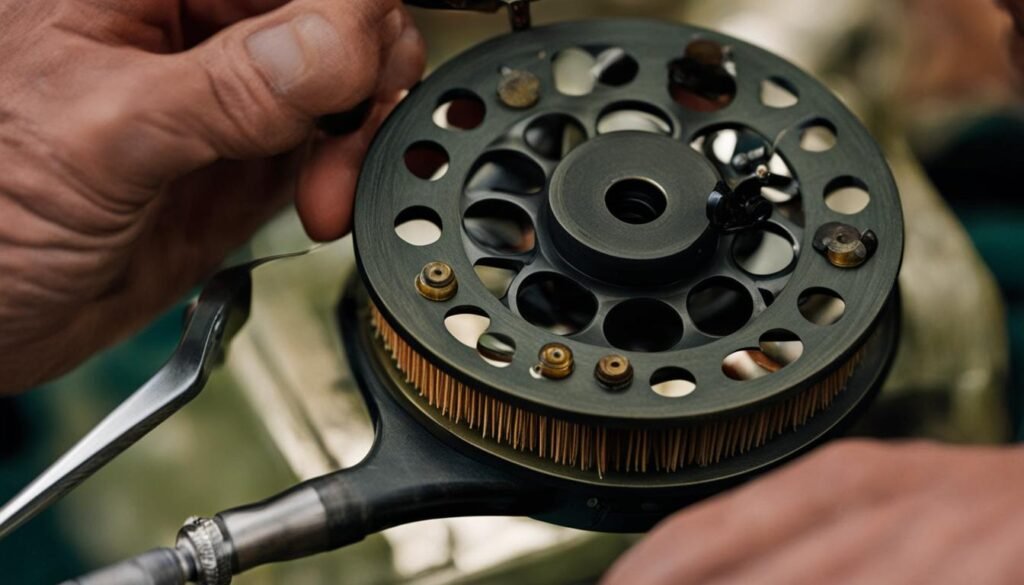
The Benefits of Maintaining Your Reels
Maintaining your fly reel comes with a wide range of benefits that contribute to its overall performance and longevity. By following a regular maintenance routine, you can:
- Extend the lifespan of your reel, ensuring it remains functional for years to come
- Improve the performance of your reel, allowing for smoother casts and retrieves
- Protect your reel from corrosion, wear, and damage caused by exposure to the elements
Properly maintained reels not only function better but also provide peace of mind when out on the water. By investing a little time and effort in maintenance, you can significantly enhance your fly fishing experience.
Necessary Tools for Reel Maintenance
To properly maintain your fly reel, you will need a few essential tools. A reel maintenance kit is a convenient option as it contains all the necessary items for reel cleaning and maintenance. The kit typically includes:
- Reel Grease: Abu Garcia Reel Grease is a popular choice among anglers. This low viscosity formula is resistant to both heat and cold, making it ideal for high-performance parts. It provides smooth and consistent reel operation.
- Reel Oil: Abu Garcia High-Speed Reel Oil is another essential product for reel maintenance. This specially formulated oil is designed to enhance the performance of all reel types, ensuring smooth casts and retrieves.
- Cleaning Products: In addition to reel grease and reel oil, it’s important to have reel cleaning products to remove dirt, grime, and saltwater residue. Brands like Penn offer reel cleaning solutions that provide unparalleled saltwater corrosion protection.
Having these tools on hand will enable you to effectively clean, lubricate, and protect your fly reel, ensuring its longevity and peak performance.
Comparison of Reel Maintenance Kits

With the right reel maintenance kit and tools, you’ll be able to keep your fly reel in top condition and enjoy many successful fishing trips.
Cleaning Your Fly Reel
Regularly cleaning your fly reel is a crucial step in maintaining its performance and longevity. By keeping your reel free from dirt, grime, and debris, you can ensure smooth operation and prevent premature wear. Follow these steps to effectively clean your fly reel:
- Start by using a soft cloth or brush to remove any surface dirt or grime. Gently wipe down the exterior of the reel, paying attention to the handle, spool, and drag system.
- For a more thorough clean, it is recommended to disassemble the reel following the manufacturer’s instructions. This allows you to access and clean all the reel components properly.
- Once the reel is disassembled, use a reel cleaning product like Penn Reel Oil. Apply a small amount of the oil to a soft cloth or brush, and gently clean the gears, spool, bail, and other moving parts. This will help remove any built-up dirt or debris and protect the components.
- Make sure to pay extra attention to the gears and moving parts of the reel, as these areas are prone to wear and require proper lubrication. Apply a suitable reel grease, such as Abu Garcia Reel Grease, to ensure smooth operation.
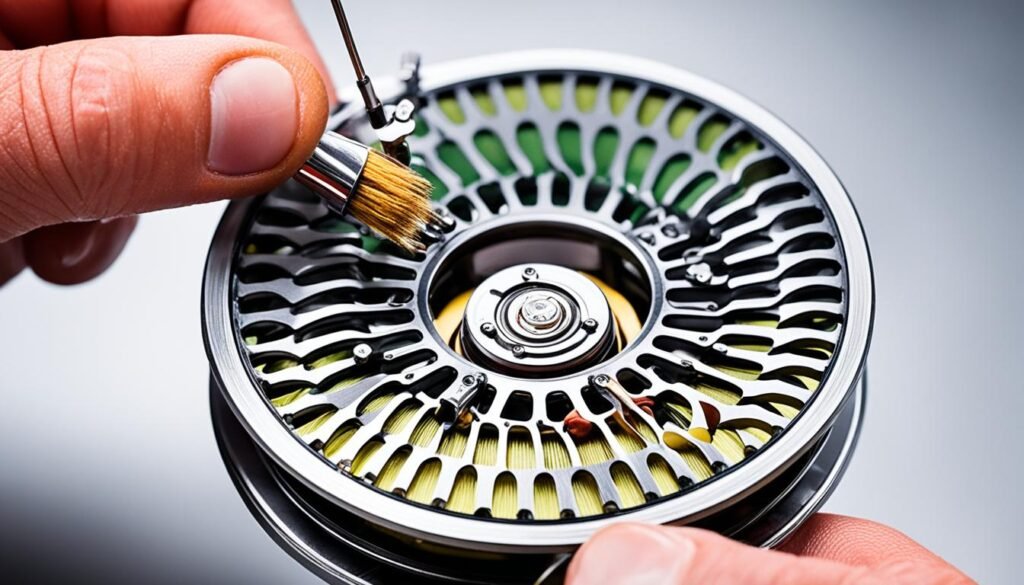
After cleaning and lubricating all the components, carefully reassemble the reel, ensuring everything is properly aligned and tightened. Double-check that the reel is functioning smoothly by turning the handle and checking for any resistance or grinding sounds.
By following these steps and using high-quality reel cleaning products, you can maintain the performance and longevity of your fly reel, ensuring it remains in optimal condition for your next fishing adventure.
Lubricating Your Fly Reel
Lubrication plays a vital role in the maintenance of your fly reel. By applying reel grease and oil, you can ensure the smooth functioning of your reel’s components and extend its wear life.
When lubricating your fly reel, it is important to use the right products for optimal performance. Consider using Abu Garcia Reel Grease, a high-quality reel lubricant specifically designed for fly reels. This low viscosity formula is perfect for lubricating gear systems and other moving parts, providing smooth operation and preventing friction-induced damage.
To apply reel grease, start by disassembling your reel as per the manufacturer’s instructions. Apply a small amount of grease to the gears and moving parts using a clean brush or applicator. Be sure to distribute the grease evenly to ensure all components are properly lubricated.
In addition to reel grease, it is also crucial to use reel oil to lubricate the bearings and joints of your fly reel. Abu Garcia High-Speed Reel Oil is a great choice for this purpose. Its advanced formulation allows for low-friction operation, reducing wear and tear on the bearings and joints.
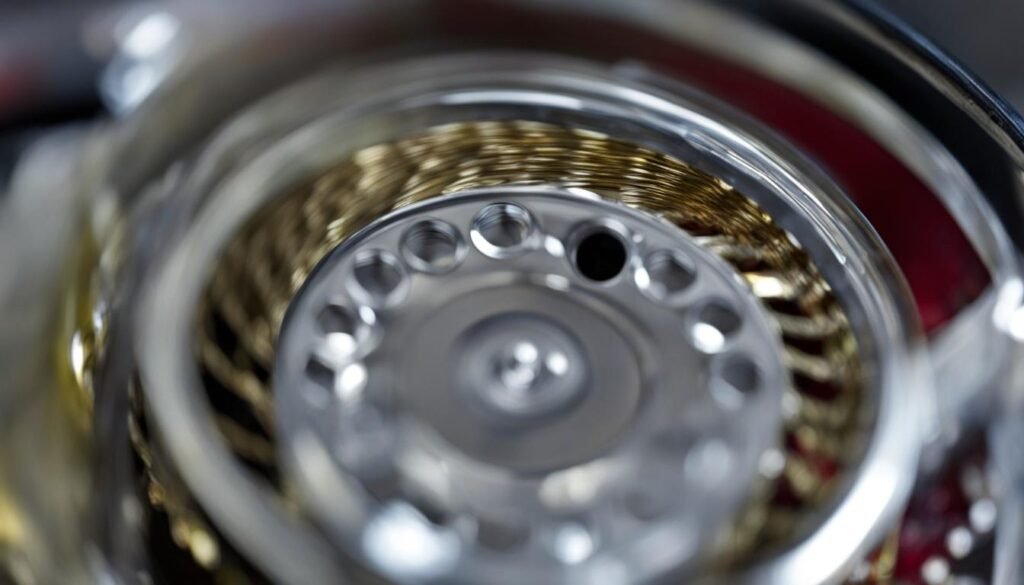
When applying reel oil, use a few drops and carefully apply it to the bearings and joints. Gently rotate the reel handle to ensure the oil spreads evenly and reaches all necessary areas. This will optimize the performance of your reel, providing smooth and effortless casting and retrieval.
Regularly lubricating your fly reel’s components, including gears, moving parts, bearings, and joints, will help prevent corrosion, reduce friction, and extend the overall lifespan of your reel. By incorporating reel grease and oil into your maintenance routine, you can enjoy a well-functioning reel that performs at its best every time you step on the water.
Reassembling and Storing Your Fly Reel
Once you have completed the reel cleaning and lubrication process, it is time to reassemble your fly reel and store it properly to maintain its optimal performance. Follow these steps to ensure a smooth reassembly and to store your reel in the best possible condition:
- Check all components: Carefully inspect each part of your reel to make sure nothing is left out. Look for any signs of damage or wear that may require repair or replacement.
- Reassemble with care: Piece together the reel components according to the manufacturer’s instructions. Pay close attention to the alignment and placement of each part to ensure everything fits snugly and moves freely.
- Final lubrication: Before storing, apply a thin layer of reel lubricant to the gears and moving parts. This will provide additional protection against friction and corrosion during storage.
Pro Tip: When reassembling your reel, take note of any specialized tools or techniques recommended by the manufacturer. These guidelines will help you achieve a seamless reassembly and ensure the longevity of your fly reel.
Once your fly reel is reassembled, it’s essential to store it properly to avoid moisture buildup and corrosion. Follow these storage tips for long-lasting reel performance:
- Choose a cool, dry place: Store your fly reel in a cool, dry location, away from direct sunlight. Extreme temperatures and humidity can damage the reel’s internal components.
- Avoid moisture: Moisture is the greatest enemy of reel longevity. Keep your fly reel in a moisture-free environment to prevent rust and corrosion from developing over time.
- Use reel covers or cases: Consider using reel covers or cases to provide an extra layer of protection against dust, dirt, and accidental damage. These accessories are designed to fit your specific reel model and offer added peace of mind during storage and transportation.
Expert Advice: Storing your reels upright in a reel case or box can be an excellent way to prevent them from tangling with other equipment or affecting the line. This method keeps your reels organized and easily accessible, while also protecting them from potential damage.
By reassembling your fly reel carefully and storing it in a suitable environment, you can ensure its longevity and top-notch performance season after season.
Comparison of Reel Storage Options
| Storage Option | Advantages | Disadvantages |
|---|---|---|
| Reel Covers | Provides physical protection Keeps dust and dirt away Fits various reel sizes |
No moisture protection May not prevent impacts |
| Reel Cases | Offers all-round protection Durable and padded materials Perfect for transportation |
Slightly bulkier than covers May be more expensive |
| Rod Tubes with Built-in Reel Storage | Convenience of keeping rod and reel together Strong and durable material Optimal for travel |
Less flexibility in storage May require additional rod tube |
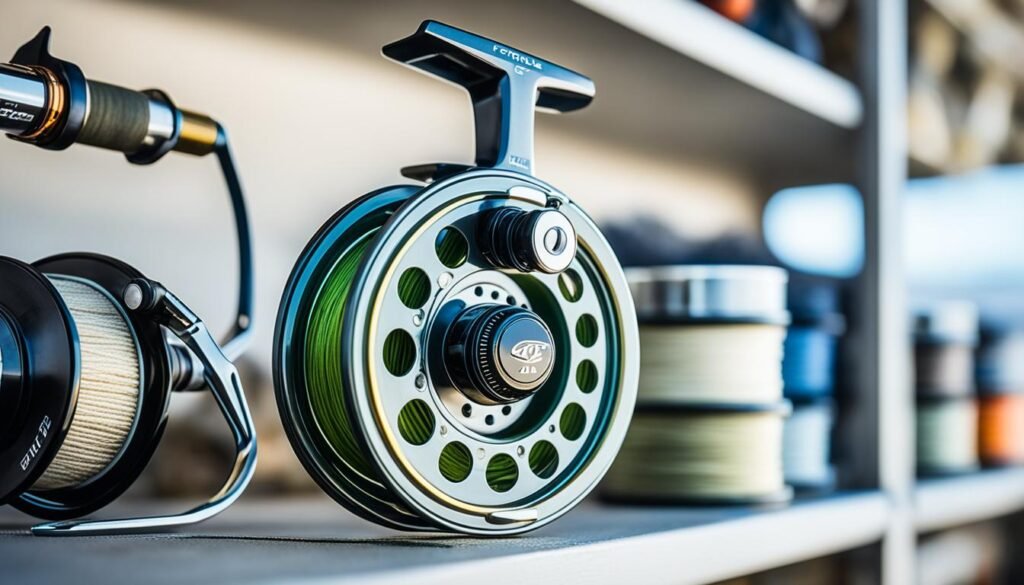
Preventative Measures during Fishing Sessions
To ensure the longevity and optimal performance of your fly reel, it is crucial to take preventative measures during your fishing sessions. By implementing a few simple practices, you can prevent debris buildup, protect your reel from sand and water, and maintain its functionality for years to come.
On-Stream Rinse
One effective preventative measure is to perform an on-stream rinse every time you set your reel down. This process involves wading into shallow water and dunking the reel to rinse away any sand, silt, or debris that may have accumulated in the line coils and between the spool and reel frame. By dedicating just a few seconds to this quick and simple procedure, you can significantly prolong the life of your reel and prevent potential damage caused by debris buildup.
Not only does the on-stream rinse remove harmful particles from your reel, but it also helps protect it from the damaging effects of sand and water. Sand can cause friction, leading to wear and tear on crucial components of your reel, while water can lead to corrosion and rust. The on-stream rinse serves as a protective barrier, ensuring your reel remains in optimal condition throughout your fishing sessions.

Preventing Debris Buildup
Preventing debris buildup is essential to maintain the smooth operation of your fly reel. In addition to the on-stream rinse, there are a few additional measures you can take:
- Regularly check your line for any signs of debris or tangles. If you notice any, remove them carefully to prevent them from entering your reel.
- Avoid setting your reel down on dirty or sandy surfaces. Instead, opt for clean, dry areas where debris is less likely to accumulate and transfer to your reel.
- During breaks or pauses in your fishing session, be mindful of where you place your reel. Keeping it in a protected location, such as a reel case or pouch, can help prevent debris from lodging in the moving parts.
Rinsing Reel After Fishing
Once your fishing session is over, it is crucial to rinse your reel to remove any residual salt, sand, or other potential contaminants. Rinse the reel thoroughly using cool, low-pressure freshwater. Avoid using hot water, as it can damage the reel’s internal components. After rinsing, gently dry the reel with a clean cloth or towel before storing it to prevent moisture buildup and corrosion.
Remember, prevention is key when it comes to maintaining your fly reel’s performance. By practicing on-stream rinses, preventing debris buildup, and rinsing your reel after each fishing session, you can ensure that your reel remains in excellent condition, providing consistent and reliable performance for all your fly fishing adventures.
Diagnostic Checks and Post-Fishing Maintenance
After each fishing session, it is important to perform a quick functional diagnostic on your fly reel to ensure its optimal performance. By conducting these checks and following proper post-fishing maintenance, you can prolong the lifespan of your reel and maintain its functionality season after season.
Start by winding the reel with all the line and leader and pay close attention to any unusual sounds or sensations. Listen for grinding sounds or feel for stickiness or stiffness, as these can indicate the presence of debris in the reel. This diagnostic check allows you to identify any issues before they worsen and affect your fishing experience.
Inspect all parts of the reel for possible damage, such as bent spindles or frames. Any noticeable damage should be addressed promptly to prevent further issues and ensure the longevity of your reel.
If you discover any debris or grime during the diagnostic check, it is essential to rinse the reel immediately. This will help remove any trapped debris that may affect the reel’s performance. Use cool, low-pressure freshwater to rinse the reel frame and lined spool thoroughly, ensuring that all remnants of dirt or saltwater are removed.
Once the reel is rinsed, take the necessary steps to dry it before storage. Proper drying is crucial to prevent moisture buildup, which can lead to corrosion and other damage. Gently wipe the reel with a clean, dry cloth to remove any excess moisture, and allow it to air dry completely before storing it in a cool, dry place.
Dedicating a few minutes to these diagnostic checks and post-fishing maintenance practices will help keep your fly reel in optimal condition, ensuring its reliability and functionality for future fishing adventures.
Conclusion
Proper fly reel maintenance is crucial to maximize performance and prolong the lifespan of your reel. With the right maintenance practices, you can ensure that your fly reel is always ready for action and delivers flawless functionality season after season.
By following these fly reel maintenance tips, you can improve the performance of your reel and prevent unnecessary wear and tear. Regular cleaning and lubrication will keep your reel in top shape and prevent corrosion or damage. Additionally, practicing proper storage techniques and taking preventative measures during fishing sessions will further extend the lifespan and functionality of your reel.
Remember to clean your reel regularly, using reel cleaning products such as Penn Reel Oil and Abu Garcia Reel Grease. Lubricate the gears, moving parts, bearings, and joints with appropriate reel grease and reel oil for smoother action and enhanced wear life. Always reassemble your reel carefully, making sure all components are in place and functioning properly.
During fishing sessions, take preventative measures to protect your reel from debris, sand, and water by using an on-stream rinse. This simple step can greatly prolong the life of your reel and prevent damage caused by the elements.
By implementing these proper maintenance practices, you can significantly improve your reel’s performance, prolong its lifespan, and ensure that it remains in top condition for countless successful fishing trips.
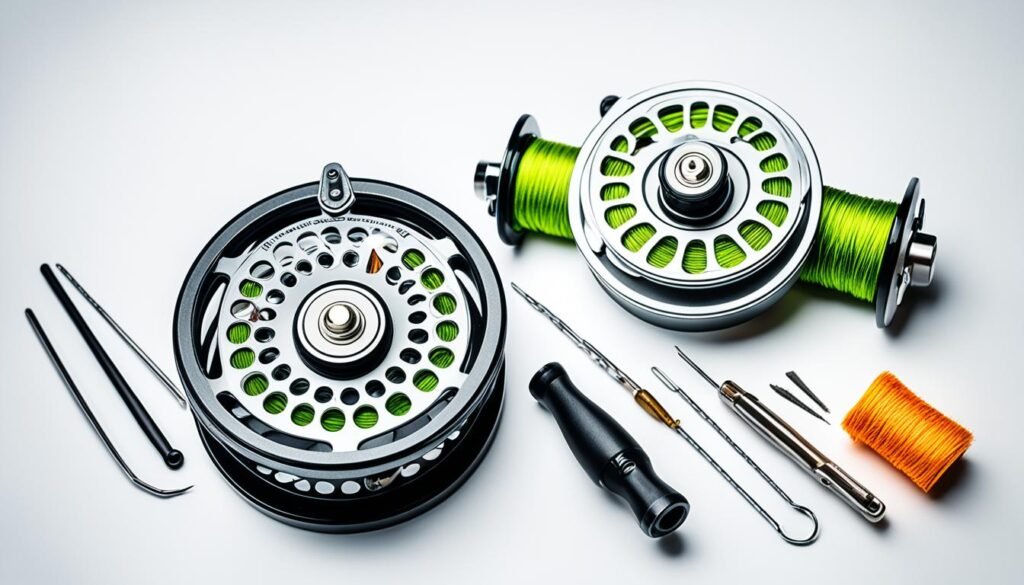
| Benefits of Proper Fly Reel Maintenance |
|---|
| Extend the lifespan of your reel |
| Improve reel performance |
| Enhance functionality and casting accuracy |
| Prevent corrosion and damage |
Stay Updated with Dark Skies Fly Fishing
If you found this article helpful, stay up to date with Dark Skies Fly Fishing by signing up for their monthly newsletter. By subscribing, you’ll receive the latest posts on fly fishing news, tricks, tips, and techniques, as well as valuable stream reports. Stay informed about new flies and equipment, and gain access to exclusive discounts and offers in their online store.
Don’t miss out on valuable information and resources that can enhance your fly fishing experience. Whether you’re a seasoned angler or just starting out, the Dark Skies Fly Fishing newsletter is a must-have resource. Get insider knowledge, expert advice, and stay connected with the fly fishing community.
Sign up now and take your fishing to the next level! Stay updated with the latest trends, techniques, and gear in the world of fly fishing. Don’t let the chance slip away to join a community of passionate anglers who are always ahead of the curve. Embrace the opportunity to receive exclusive offers, improve your skills, and stay connected with the world of fly fishing.
FAQ
Why is maintaining a fly reel important?
Maintaining your fly reel is important to extend its lifespan, improve its performance, and protect it from corrosion and wear.
What tools do I need for fly reel maintenance?
You will need a reel maintenance kit, which typically includes reel grease and reel oil, such as Abu Garcia Reel Grease and High-Speed Reel Oil or Penn Reel Grease and Reel Oil.
How do I clean my fly reel?
To clean your fly reel, start by using a soft cloth or brush to remove surface dirt and grime. For a deeper clean, follow the manufacturer’s instructions to disassemble the reel and use reel cleaning products, such as Penn Reel Oil, to clean and protect the components.
How do I lubricate my fly reel?
Apply reel grease, like Abu Garcia Reel Grease, to the gears and moving parts of your reel. Use reel oil, such as Abu Garcia High-Speed Reel Oil, to lubricate the bearings and joints for smoother action and extended wear life.
How should I store my fly reel?
After cleaning and lubricating your fly reel, reassemble all the components and store it in a cool, dry place away from direct sunlight and extreme temperatures.
What preventative measures can I take during fishing sessions?
To prevent debris buildup, use an on-stream rinse by dunking the reel in shallow water to rinse away any trapped sand, silt, or debris. This quick procedure helps prolong the life of your reel.
What diagnostic checks should I perform on my reel after each fishing session?
After each fishing session, wind the reel with all the line and leader to check for grinding sounds, stickiness, or stiffness, which may indicate debris in the reel. Inspect all parts for damage and rinse the reel immediately if necessary. When you’re home, rinse the reel frame and lined spool with freshwater, dry them thoroughly, and store them properly.
Why is proper fly reel maintenance important?
Proper fly reel maintenance is crucial to ensure peak performance, prolonged lifespan, and flawless functionality season after season.
How can I stay updated with fishing news and tips?
Sign up for the Dark Skies Fly Fishing monthly newsletter to receive the latest posts on fly fishing news, tricks, tips, and techniques, stream reports, updates on new flies, and exclusive discounts in their online store.

